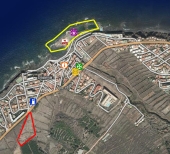I live in Sweden and built a compost bin system out of pallets ect. since we are cold here, the compost does not get hot in the winter obviously unless you have a green house and alot of organic matter handy. Plus vegetation largely dwindles. we added food scraps to it through the winter anyhow. I will tell you that this was a extremely bad idea. it attracted rats... now It is spring and the rats are flourishing. Rats have no place in a ecology in my opinion, carry a-lot of disease and attack birds eggs and birds. They have largely been propagated around the world by humans, from boats, cars, planes ect.
do not make this mistake. Don't compost your food scraps in a open enviroment if there is a threat of rats. If you do need to, save it sealed ups nd build a proper compost system where you do full batches (or think of another way to do it, there are other alternatives), at least 1 cubic meter in size with proper nitrogen carbon ratios that the compost gets hot and decomposes correctly. you do not want a cold compost full of food scraps attracting rodents. it is just not worth it. Look into the biology of rats and the disease they Cary and how they contaminate the compost with their urine.
http://www.ratbehavior.org/RatBiologyMain.htm
in my opinion it is worth killing them no matter what, especially if you have kids which I have! check this, listen to the interview, this is a major problem for island bio geography.
http://www.bbc.com/news/science-environment-44046472
what I did was, took apart the whole compost bin, trashed all the food scraps and brought it too the dump. clean up all the vegetation and mess around, added a-lot of soil on top of where the compost used to be, got the neighbours cats to come over, and had rat professional come and set up traps to erratic them. Not only where they in the compost pile, I discovered they where trying to eat though a back door to our basement that we did not look at much in the winter and they did considerable damage, plus they were able to create a a good sized hole in a outdoor cement floor...... !
Do not provide any ecological niches for rats to occupy, plus provide predators for their determent.. This was a major mess and a steep learning curve I wanted to share so that other people can benefit from this mistake.
There has been a discussion about cats on this forum, either good or bad for permaculture...... regardless they are a predator to rats, whatever works works.
There are still rat holes in the ground and I will now continue the processes of cleaning of the vegetation and making it so they do not have any habitat to occupy, plus they may be in the the small barn!!
Did you know at one point in the earths history rodents dominated the landscape and where much larger, bigger than a dog. their success is in part due to their teeth, they can naw through wood and cement and eat virtually anything.
I have no sympathy for them, and no matter where I am I will do my best to completely eradicate them.... if you think otherwise comment to this and justify your reasoning



